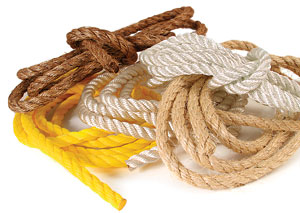
Rope comes in many varieties, and each type has strengths and weaknesses. Selecting the wrong rope for a job can lead to consequences ranging from embarrassment (losing a load of building material from your truck) to sudden death (falling while you’re connected to a nonelastic safety line), so it’s important to understand the differences.
Unfortunately, the most-common type of rope in hardware and building-supply stores is three-strand yellow polypropylene. Polypro is widely available because it’s cheap, not because it’s particularly useful. In fact, polypro has a limited number of applications, few of which are likely to be encountered on a construction site or around the home. Here are four other three-strand ropes worth considering. To get quality rope, including specialty braided products, visit a specialty online retailer, such as www.phoenixrope.com or www.neropes.com.
Manila
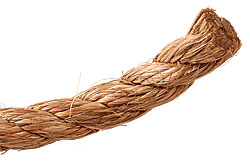
Realitive strength: Medium
Chafe resistance: Medium high
Elasticity: Low
Knot-holding qualities: Very good
Uses: Manila is the best natural-fiber rope to use in block-and-tackle assemblies and other hoisting applications because it’s stiff and does not stretch. It is only fair for lashing due to its stiffness. Manila fibers are rough, which makes a rope easy to grip, but it’s best to wear gloves to avoid splinters. Virtually all manila is treated with oil to make it less subject to rot, but it should be kept dry if possible and be dried before storing. At just under $1 per ft. for 5/8 in. dia., manila is a moderately priced rope.
Sisal

Realitive strength: Low
Chafe resistance: Low
Elasticity: Low
Knot-holding qualities: Fair
Uses: Sisal has short fibers, which make it relatively weak. Use it only for general-purpose tasks around the home and garden, not for lashing down anything of great value. Thin sisal is great for tying up packages or bundles of trim or shims. Sisal is not oiled like manila, so it rots easily, which makes it a poor rope for use in wet conditions. Because it’s not oiled, however, it can be disposed of in a compost pile when it is no longer needed. Sisal is one of the least-expensive ropes available.
Polyester
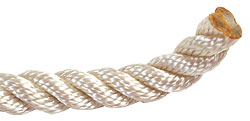
Realitive strength: High
Chafe resistance: Medium
Elasticity: Low
Knot-holding qualities: Fair to good
Uses: Polyester is the best synthetic-fiber rope for hoisting material due to its stiffness and nonelasticity. It is also excellent for making slings to lift material. Look for soft-laid polyester when tying down loose items because it’s easier to knot than hard-laid polyester. Polyester is not affected by moisture, which means it can be stored in the wet bed of a truck without rotting. Note: Polyester is commonly known by the brandname Dacron and is comparable in cost to nylon at a little over $1 per ft. for 5/8 in. dia.
Nylon
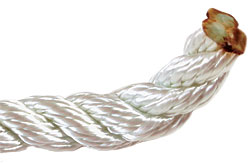
Realitive strength: High
Chafe resistance: Medium
Elasticity: High
Knot-holding qualities: Good
Uses: Due to its elasticity and strength, nylon is the best rope to use to pull a vehicle out of mud or snow. It also can be used as a fall-protection safety line when working on a roof or on scaffolding. Taking a fall while attached to a nylon rope that stretches is much safer than if attached to a polyester rope that does not. As with polyester, nylon does not rot and can be stored wet. It’s not the best for hoisting or lashing, though, because it stretches too much. Polyester and nylon ropes are virtually indistinguishable by sight and cost roughly the same amount of money, so be sure you’re using the correct rope for the job.
Polypropylene
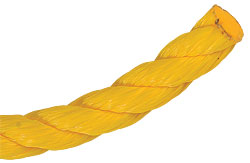
Realitive strength: Medium low
Chafe resistance: Medium
Elasticity: Low
Knot-holding qualities: Poor
Uses: Polypro floats, so it’s the best rope for applications in or around water. It can be used for light, temporary tie-down applications, but it does not hold knots well. Like other synthetic ropes, polypro does not rot if stored wet. Polypro isn’t the easiest rope to work with, however. The fibers have a high degree of shape memory and retain the form of a knot after the rope is untied, making the rope difficult to knot or coil. Polypro is slick when new, which makes it hard to grip, and it’s prickly when it’s old, a sure indication its useful life is over. Its cost is comparable to sisal.
Safety note: Never use rope as a safety line unless it has been rated or approved for that use.
Photos by: Krysta S. Doerfler
Fine Homebuilding Recommended Products
Fine Homebuilding receives a commission for items purchased through links on this site, including Amazon Associates and other affiliate advertising programs.

Handy Heat Gun

Affordable IR Camera

8067 All-Weather Flashing Tape






















